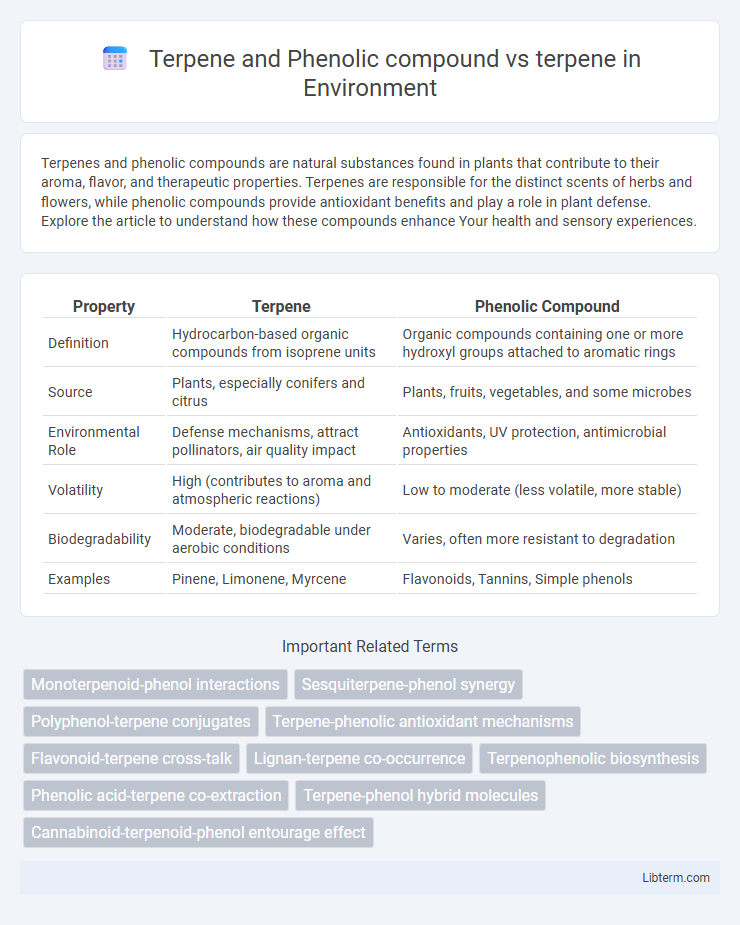Terpenes and phenolic compounds are natural substances found in plants that contribute to their aroma, flavor, and therapeutic properties. Terpenes are responsible for the distinct scents of herbs and flowers, while phenolic compounds provide antioxidant benefits and play a role in plant defense. Explore the article to understand how these compounds enhance Your health and sensory experiences.
Table of Comparison
| Property | Terpene | Phenolic Compound |
|---|---|---|
| Definition | Hydrocarbon-based organic compounds from isoprene units | Organic compounds containing one or more hydroxyl groups attached to aromatic rings |
| Source | Plants, especially conifers and citrus | Plants, fruits, vegetables, and some microbes |
| Environmental Role | Defense mechanisms, attract pollinators, air quality impact | Antioxidants, UV protection, antimicrobial properties |
| Volatility | High (contributes to aroma and atmospheric reactions) | Low to moderate (less volatile, more stable) |
| Biodegradability | Moderate, biodegradable under aerobic conditions | Varies, often more resistant to degradation |
| Examples | Pinene, Limonene, Myrcene | Flavonoids, Tannins, Simple phenols |
Introduction to Terpenes and Phenolic Compounds
Terpenes are a diverse class of organic compounds produced primarily by plants, known for their aromatic properties and roles in plant defense. Phenolic compounds, distinct yet often co-occurring with terpenes, contain one or more hydroxyl groups attached to an aromatic ring, contributing antioxidant and antimicrobial benefits. Both terpenes and phenolic compounds play crucial roles in plant physiology, influencing flavor, aroma, and therapeutic potential in herbal and pharmaceutical applications.
Chemical Structure: Terpenes vs Phenolic Compounds
Terpenes are hydrocarbons built from repeating isoprene units (C5H8) forming linear or cyclic structures, whereas phenolic compounds feature an aromatic benzene ring bonded to one or more hydroxyl groups (-OH). The chemical structure of terpenes lacks oxygen functional groups unless modified, while phenolics are distinct for their hydroxyl substitution on the aromatic ring, contributing to higher polarity. This structural difference influences their chemical reactivity, solubility, and biological activities, with terpenes primarily hydrophobic and phenolic compounds exhibiting antioxidant properties due to their hydroxyl groups.
Natural Sources of Terpenes and Phenolics
Terpenes and phenolic compounds are naturally abundant in a variety of plants, with terpenes primarily found in coniferous trees, citrus fruits, and aromatic herbs like lavender and rosemary, contributing to their distinctive scents. Phenolic compounds, including flavonoids and tannins, are prevalent in fruits such as berries, grapes, and apples, as well as in tea leaves and certain spices, playing a crucial role in antioxidant activity. Both terpenes and phenolics serve important ecological functions in plants, providing protection against pests and UV radiation while also offering significant health benefits when consumed.
Extraction Methods for Terpenes and Phenolic Compounds
Extraction methods for terpenes often involve steam distillation and solvent extraction, which effectively capture volatile aromatic compounds from plants. Phenolic compounds, being less volatile and more water-soluble, require techniques such as solvent extraction with polar solvents, ultrasonic-assisted extraction, or microwave-assisted extraction to maximize yield and preserve bioactivity. Advanced methods like supercritical CO2 extraction selectively isolate terpenes due to their non-polar nature, whereas phenolics respond better to aqueous or alcohol-based extractions, highlighting the necessity to tailor techniques based on chemical properties.
Biological Activities: Comparison of Terpenes and Terpene-Phenolic Complexes
Terpene-phenolic complexes exhibit enhanced antioxidant and anti-inflammatory activities compared to terpenes alone due to the synergistic interactions between terpene structures and phenolic hydroxyl groups. Phenolic compounds contribute to radical scavenging and enzyme modulation, amplifying the biological efficacy of terpene-based formulations. Studies reveal that terpene-phenolic conjugates possess superior antimicrobial and cytoprotective properties, making them promising candidates for therapeutic applications.
Role in Plant Defense: Terpenes versus Phenolic Compounds
Terpenes serve as volatile organic compounds that repel herbivores and attract predators of plant pests, playing a crucial role in indirect plant defense. Phenolic compounds contribute to direct defense by strengthening cell walls and exhibiting antimicrobial properties against pathogens. Together, terpenes and phenolics create a multifaceted defense system, with terpenes mediating ecological interactions and phenolics providing structural and chemical barriers.
Therapeutic Potentials of Terpenes and Phenolics
Terpenes and phenolic compounds exhibit distinct therapeutic potentials, with terpenes known for their anti-inflammatory, analgesic, and antimicrobial properties that support respiratory and neurological health. Phenolic compounds, rich in antioxidants, primarily combat oxidative stress and reduce inflammation, contributing to cardiovascular and cancer prevention. The synergistic interaction between terpenes and phenolics enhances their bioavailability and efficacy in treating chronic diseases and promoting overall wellness.
Flavor and Aroma Contributions: Terpenes vs Terpene-Phenolic Interactions
Terpenes are primary contributors to flavor and aroma in plants, offering distinct scents such as citrus, pine, and floral notes, while phenolic compounds enhance complexity by adding spicy, smoky, or bitter undertones. The interaction between terpenes and phenolic compounds creates unique flavor profiles through synergistic effects that modulate volatility and perception of aromatic intensity. These terpene-phenolic interactions are crucial in industries like food, beverage, and cannabis, where nuanced aroma and flavor differentiation drive consumer preference.
Industrial Applications: Single Terpenes vs Combined Terpene-Phenolic Compounds
Single terpenes are widely utilized in industries such as perfumery, flavoring, and pharmaceuticals due to their distinct aromatic properties and bioactivities. Combined terpene-phenolic compounds exhibit enhanced antioxidant and antimicrobial effects, making them valuable for food preservation, cosmetics, and pharmaceutical formulations with improved stability and efficacy. Industrial applications leverage the synergy of terpene-phenolic combinations to develop multifunctional products that surpass the performance of isolated terpenes alone.
Future Perspectives and Research Directions
Future perspectives in terpene and phenolic compound research explore their synergistic bioactivities and enhanced therapeutic potentials compared to isolated terpenes. Investigations focus on optimizing extraction methods and molecular modifications to improve efficacy and stability in pharmaceutical and nutraceutical applications. Emerging studies emphasize advanced omics technologies and bioinformatics to elucidate metabolic pathways and accelerate the development of novel dual-action compounds.
Terpene and Phenolic compound Infographic

 libterm.com
libterm.com